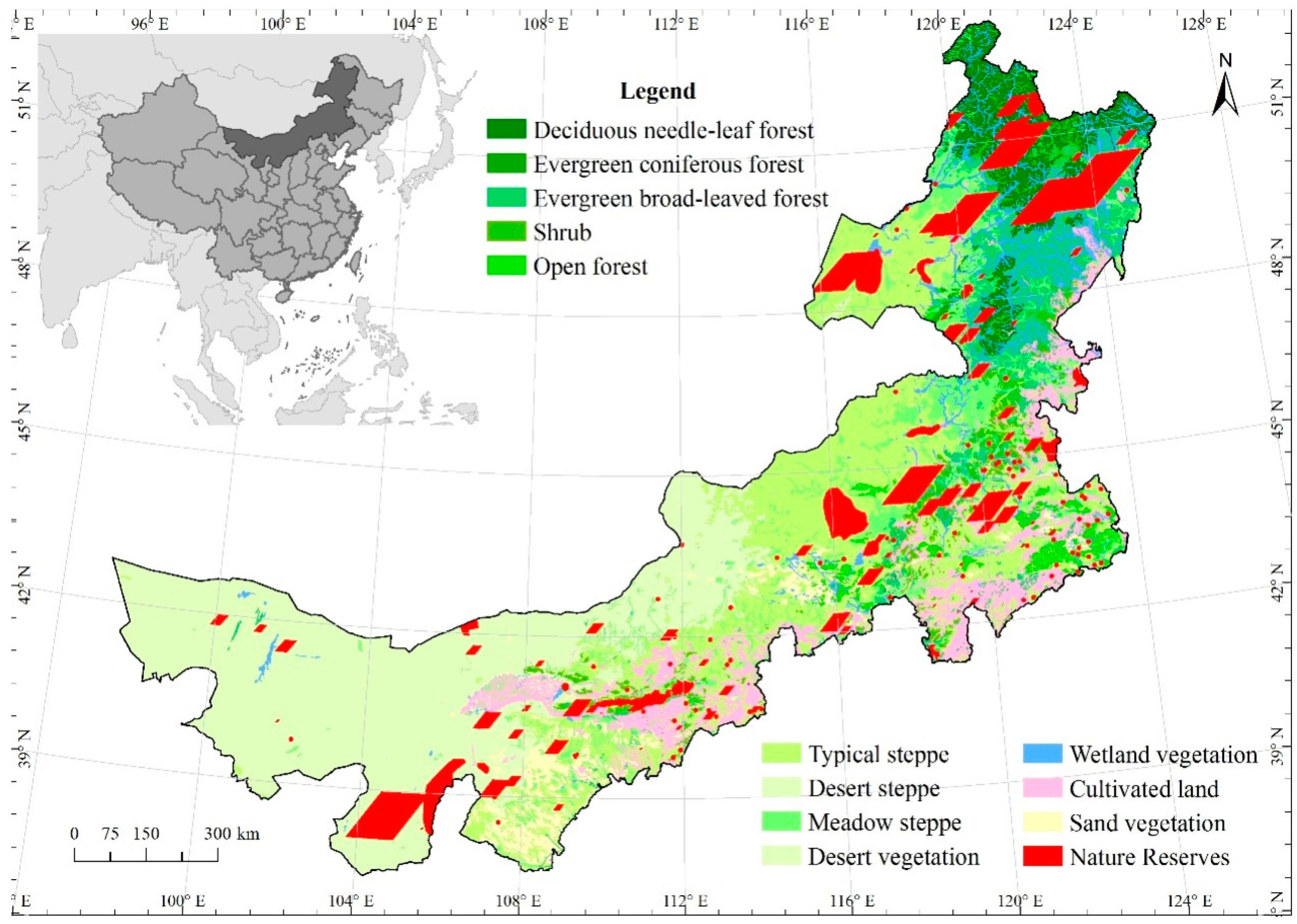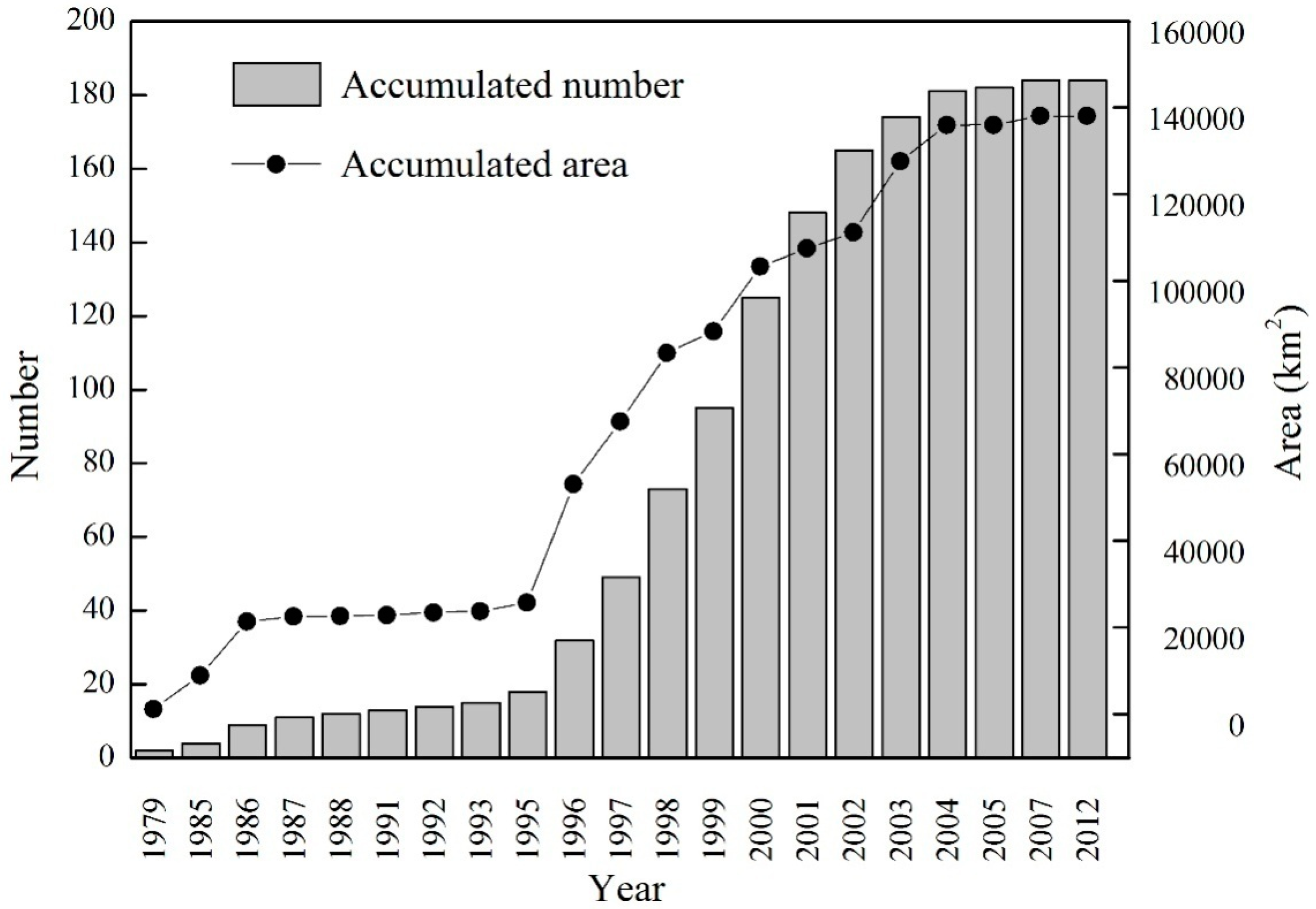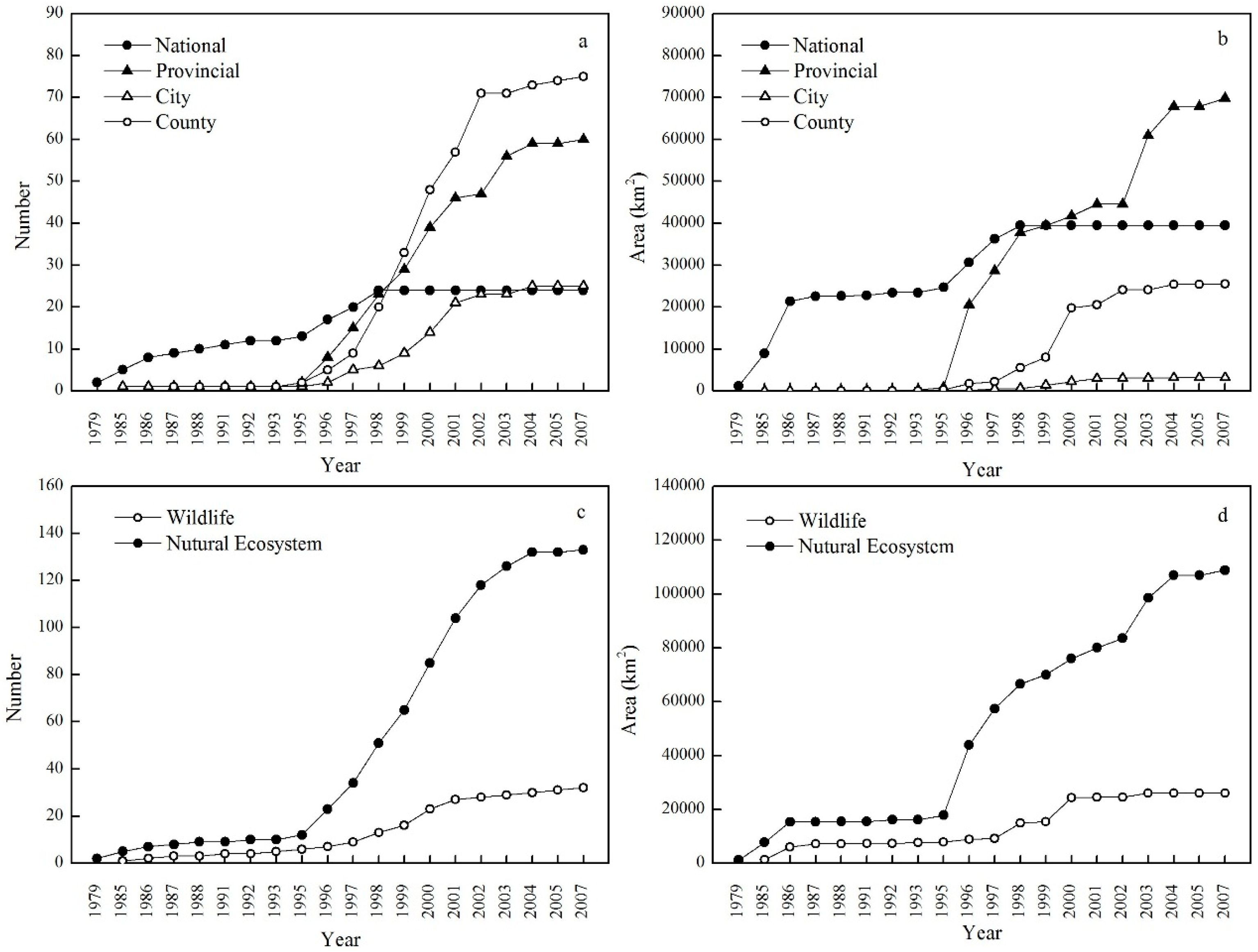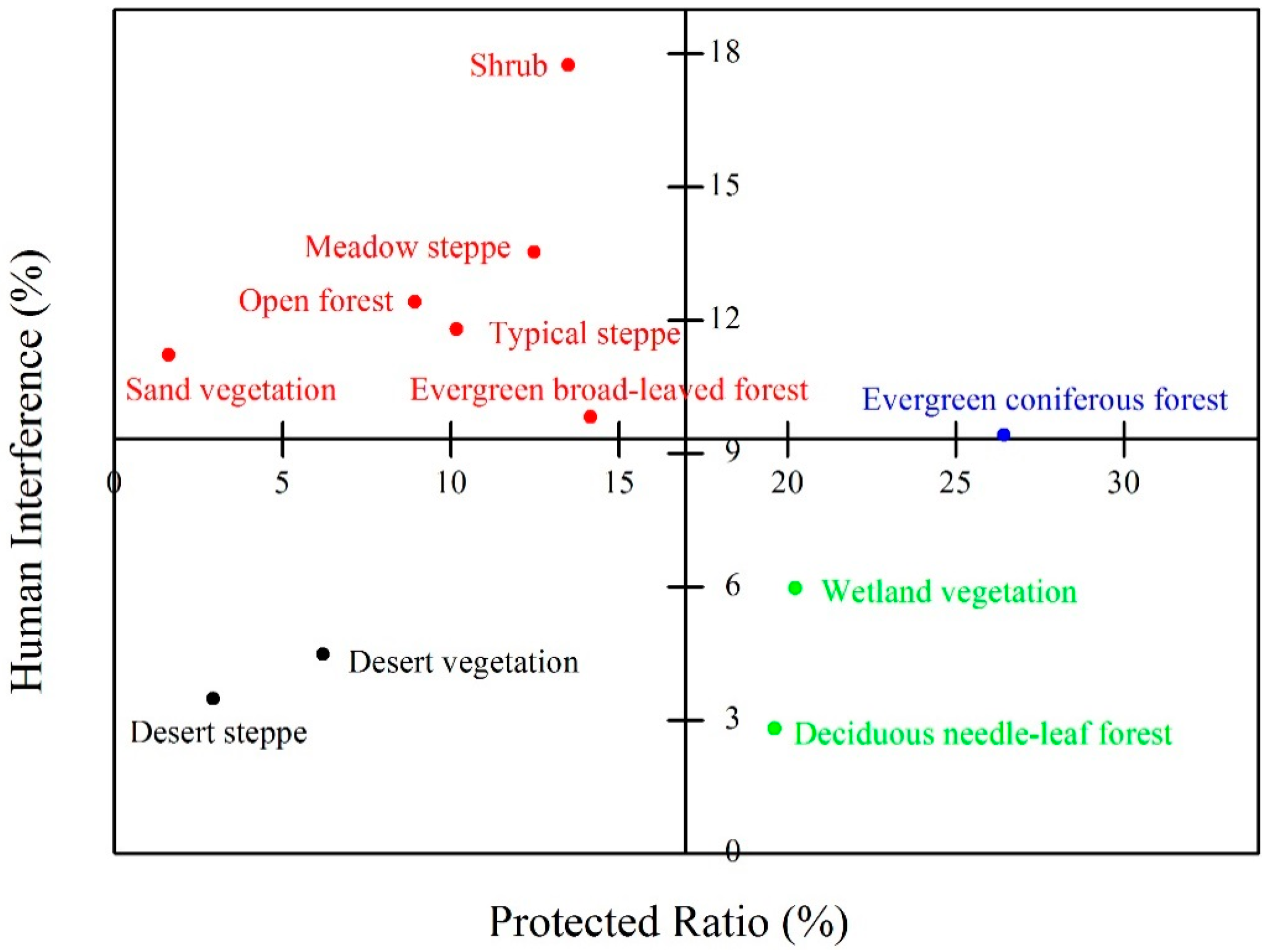Status of Nature Reserves in Inner Mongolia, China
Abstract
:1. Introduction
2. Methods
2.1. Study Area
2.2. Data and Analysis
2.2.1. Nature Reserves
2.2.2. Vegetation Types
2.2.3. Human Interference
3. Results
3.1. Current Status of Nature Reserves
3.2. Temporal Pattern of Nature Reserves in Inner Mongolia
3.3. Protection Ratio of Vegetation Types and Human Interference
4. Discussion
4.1. Changes in Nature Reserves of Inner Mongolia
4.2. Protected Areas and Human Interference
4.3. Recommendations for Sustainable Management
5. Conclusions
Acknowledgments
Author Contributions
Conflicts of Interest
References
- Hooper, D.U.; Chapin, F.S.; Ewel, J.J.; Hector, A.; Inchausti, P.; Lavorel, S.; Lawton, J.H.; Lodge, D.M.; Loreau, M.; Naeem, S.; et al. Effects of biodiversity on ecosystem functioning: A consensus of current knowledge. Ecol. Monogr. 2005, 75, 3–35. [Google Scholar] [CrossRef]
- Le Saout, S.; Hoffmann, M.; Shi, Y.; Hughes, A.; Bernard, C.; Brooks, T.M.; Bertzky, B.; Butchart, S.H.; Stuart, S.N.; Badman, T.; et al. Protected areas and effective biodiversity conservation. Science 2013, 342, 803–805. [Google Scholar] [CrossRef] [PubMed]
- Pardo-de-Santayana, M.; Macia, M.J. Biodiversity: The benefits of traditional knowledge. Nature 2015, 518, 487–488. [Google Scholar] [CrossRef] [PubMed]
- Wake, D.B.; Vredenburg, V.T. Are we in the midst of the sixth mass extinction? A view from the world of amphibians. Proc. Natl. Acad. Sci. USA 2008, 105, 11466–11473. [Google Scholar] [CrossRef] [PubMed]
- Chapin, F.S.; Zavaleta, E.S.; Eviner, V.T.; Naylor, R.L.; Vitousek, P.M.; Reynolds, H.L.; Hooper, D.U.; Lavorel, S.; Sala, O.E.; Hobbie, S.E.; et al. Consequences of changing biodiversity. Nature 2000, 405, 234–242. [Google Scholar] [CrossRef] [PubMed]
- Pacheco, L.; Fraixedas, S.; Fernandez-Llamazares, A.; Estela, N.; Mominee, R.; Guallar, F. Perspectives on sustainable resource conservation in community nature reserves: A case study from senegal. Sustainability 2012, 4, 3158–3179. [Google Scholar] [CrossRef]
- Cao, M.; Peng, L.; Liu, S. Analysis of the network of protected areas in China based on a geographic perspective: Current status, issues and integration. Sustainability 2015, 7, 15617–15631. [Google Scholar] [CrossRef]
- Fazey, I.; Fischer, J.; Lindenmayer, D.B. What do conservation biologists publish? Biol. Conserv. 2005, 124, 63–73. [Google Scholar] [CrossRef]
- Brooks, T.M. Conservation: Mind the gaps. Nature 2014, 516, 336–337. [Google Scholar] [CrossRef] [PubMed]
- Gaston, K.J.; Jackson, S.F.; Cantú-Salazar, L.; Cruz-Piñón, G. The ecological performance of protected areas. Annu. Rev. Ecol. Evol. Syst. 2008, 39, 93–113. [Google Scholar] [CrossRef]
- Tang, Z.; Fang, J.; Sun, J.; Gaston, K.J. Effectiveness of protected areas in maintaining plant production. PLoS ONE 2011, 6, e19116. [Google Scholar] [CrossRef] [PubMed]
- Juffe-Bignoli, D.; Burgess, N.D.; Bingham, H.; Belle, E.M.; de Lima, M.G.; Deguignet, M.; Bertzky, B.; Milam, A.N.; Martinez-Lopez, J.; Lewis, E.; et al. Protected Planet Report 2014; UNEP-WCMC: Cambridge, UK, 2014. [Google Scholar]
- MacKinnon, D.; Lemieux, C.J.; Beazley, K.; Woodley, S.; Helie, R.; Perron, J.; Elliott, J.; Haas, C.; Langlois, J.; Lazaruk, H.; et al. Canada and Aichi Biodiversity Target 11: Understanding ‘other effective area-based conservation measures’ in the context of the broader target. Biodivers. Conserv. 2015, 24, 3559–3581. [Google Scholar] [CrossRef]
- Leroux, S.J.; Kerr, J.T. Land development in and around protected areas at the wilderness frontier. Conserv. Biol. 2013, 27, 166–176. [Google Scholar] [CrossRef] [PubMed]
- Secretariat of the Convention on Biological Diversity. Global Biodiversity Outlook 4; Secretariat of the Convention on Biological Diversity: Montréal, QC, Canada, 2014. [Google Scholar]
- Guo, Z.; Cui, G. Establishment of nature reserves in administrative regions of mainland China. PLoS ONE 2015, 10, e0119650. [Google Scholar] [CrossRef] [PubMed]
- Huang, H. Plant diversity and conservation in China: Planning a strategic bioresource for a sustainable future. Bot. J. Linn. Soc. 2011, 166, 282–300. [Google Scholar] [CrossRef] [PubMed]
- Wu, R.; Zhang, S.; Yu, D.W.; Zhao, P.; Li, X.; Wang, L.; Yu, Q.; Ma, J.; Chen, A.; Long, Y. Effectiveness of China’s nature reserves in representing ecological diversity. Front. Ecol. Environ. 2011, 9, 383–389. [Google Scholar] [CrossRef]
- Zhao, G.; Tian, Y.; Tang, Z.; Li, J.; Zeng, H. Distribution of terrestrial national nature reserves in relation to human activities and natural environments in China. Biodivers. Sci. 2013, 21, 658–665. [Google Scholar]
- Wu, J.; Zhang, Q.; Li, A.; Liang, C. Historical landscape dynamics of Inner Mongolia: Patterns, drivers, and impacts. Landsc. Ecol. 2015, 30, 1579–1598. [Google Scholar] [CrossRef]
- Ma, Y. Flora of Inner Mongolia; Inner Mongolia People’ Press: Hohhot, China, 1985; Volume I. (In Chinese) [Google Scholar]
- Xu, R. Fauna of Inner Mongolia; Inner Mongolia University Press: Hohhot, China, 1988; Volume I. (In Chinese) [Google Scholar]
- Zhao, Y. Classification and Its Florristic Ecological Geographic Distributions of Vascular Plants in Inner Mongolia; Inner Mongolia University Press: Hohhot, China, 2012. (In Chinese) [Google Scholar]
- Zhao, Y.; Zhao, L. Key to the Vascular Plants of Inner Mongolia; Science Press: Beijing, China, 2013. (In Chinese) [Google Scholar]
- John, R.; Chen, J.; Lu, N.; Guo, K.; Liang, C.; Wei, Y.; Noormets, A.; Ma, K.; Han, X. Predicting plant diversity based on remote sensing products in the semi-arid region of Inner Mongolia. Remote Sens. Environ. 2008, 112, 2018–2032. [Google Scholar] [CrossRef]
- Tallis, H.; Goldman, R.; Uhl, M.; Brosi, B. Integrating conservation and development in the field: Implementing ecosystem service projects. Front. Ecol. Environ. 2009, 7, 12–20. [Google Scholar] [CrossRef]
- Environment Protection of the People’s Republic of China. Available online: http://sts.mep.gov.cn/zrbhq/zrbhq/201309/t20130927_260964.shtml (accessed on 16 May 2016).
- World Database on Protected Areas. Available online: http://www.protectedplanet.net/ (accessed on 16 May 2016).
- Inner Mongolia-Ningxia Joint Inspection Group of Chinese Sciences of Academy. Vegetation of Inner Mongolia; Science Publishing House: Beijing, China, 1985. (In Chinese) [Google Scholar]
- IUCN. Parks for Life: Report of the IV World Congress on National Parks and Protected Areas; IUCN: Gland, Switzerland, 1993. [Google Scholar]
- European Space Agency. Available online: http://due.esrin.esa.int/page_globcover.php (accessed on 16 May 2016).
- Li, Y.; Xu, Z.; Li, Y. A preliminary study on the relationship between multi-scale land use & landscape and river water quality response in the Huntai watershed. Earth Environ. 2012, 40, 573–583. [Google Scholar]
- Heinonen, S.; Jokinen, P.; Kaivo-oja, J. The ecological transparency of the information society. Futures 2001, 33, 319–337. [Google Scholar] [CrossRef]
- Watson, J.E.M.; Dudley, N.; Segan, D.B.; Hockings, M. The performance and potential of protected areas. Nature 2014, 515, 67–73. [Google Scholar] [CrossRef] [PubMed]
- Deguignet, M.; Juffe-Bignoli, D.; Harrison, J.; MacSharry, B.; Burgess, N.; Kingston, N. 2014 United Nations List of Protected Areas; UNEP-WCMC: Cambridge, UK, 2014. [Google Scholar]
- Zhu, X.D. Understanding China’s Growth: Past, Present, and Future. J. Econ. Perspect. 2012, 26, 103–124. [Google Scholar] [CrossRef]
- He, F.L. Price of prosperity: Economic development and biological conservation in China. J. Appl. Ecol. 2009, 46, 511–515. [Google Scholar] [CrossRef]
- Gong, F.; Gai, Z.Y.; Chang, Q. Protection of Grassland Ecology and Sustained Economic Development in Inner Mongolia. Res. Agric. Mod. 2008, 29, 314–317. (In Chinese) [Google Scholar]
- Cantú, C.; Gerald Wright, R.; Michael Scott, J.; Strand, E. Assessment of current and proposed nature reserves of mexico based on their capacity to protect geophysical features and biodiversity. Biol. Conserv. 2004, 115, 411–417. [Google Scholar] [CrossRef]
- Bertzky, B.; Corrigan, C.; Kemsey, J.; Kenney, S.; Ravilious, C.; Besançon, C.; Burgess, N. Protected Planet Report 2012: Tracking Progress towards Global Targets for Protected Areas; IUCN: Gland, Switzerland; UNEP-WCMC: Cambridge, UK, 2012. [Google Scholar]
- Fang, J.; Wang, X.; Liu, Y.; Tang, Z.; White, P.S.; Sanders, N.J. Multi-scale patterns of forest structure and species composition in relation to climate in northeast China. Ecography 2012, 35, 1072–1082. [Google Scholar] [CrossRef]
- Peng, Y.; Jiang, G.; Niu, S.; Liu, M.; Ding, S.; Liu, S. Communities of typical sand dune fixed plants in the central part of otindag sandy region. Acta Bot. Boreali Occident. Sin. 2006, 26, 1414–1419. [Google Scholar]
- Li, X. Land desertification and biodiversity protection in Mu Us Sandy Land. J. Desert Res. 1997, 17, 60–64. [Google Scholar]
- Liu, J.; Linderman, M.; Ouyang, Z.; An, L.; Yang, J.; Zhang, H. Ecological degradation in protected areas: The case of Wolong Nature Reserve for giant pandas. Science 2001, 292, 98–101. [Google Scholar] [CrossRef] [PubMed]
- Wang, X.L.; Su, Z. Study on temporal and spatial changes of cultivated land use in Inner Mongolia based on GIS. Arid Land Geogr. 1999, 22, 71–76. [Google Scholar]
- Bai, Y.; Wu, J.; Pan, Q.; Huang, J.; Wang, Q.; Li, F.; Buyantuyev, A.; Han, X. Positive linear relationship between productivity and diversity: Evidence from the Eurasian Steppe. J. Appl. Ecol. 2007, 44, 1023–1034. [Google Scholar] [CrossRef]
- Ren, H.; Schoenbach, P.; Wan, H.; Gierus, M.; Taube, F. Effects of grazing intensity and environmental factors on species composition and diversity in typical steppe of Inner Mongolia, China. PLoS ONE 2012, 7, e52180. [Google Scholar] [CrossRef] [PubMed]
- Yu, L.L.; Garcia, A.; Chivas, A.R.; Tibby, J.; Kobayashi, T.; Haynes, D. Ecological change in fragile floodplain wetland ecosystems, natural vs. human influence: The Macquarie Marshes of eastern Australia. Aquat. Bot. 2015, 120, 39–50. [Google Scholar] [CrossRef]
- Reyers, B. Incorporating anthropogenic threats into evaluations of regional biodiversity and prioritisation of conservation areas in the Limpopo Province, South Africa. Biol. Conserv. 2004, 118, 521–531. [Google Scholar] [CrossRef]




| Class | Number | Ratio (%) | Area (km2) | Ratio (%) |
|---|---|---|---|---|
| Wildlife nature reserves | 30 | 16.3 | 26,046.11 | 18.9 |
| Natural ecosystems | 134 | 72.8 | 108,835.3 | 78.8 |
| Natural relics | 20 | 10.9 | 3165.97 | 2.3 |
© 2016 by the authors; licensee MDPI, Basel, Switzerland. This article is an open access article distributed under the terms and conditions of the Creative Commons Attribution (CC-BY) license (http://creativecommons.org/licenses/by/4.0/).
Share and Cite
Ma, W.; Feng, G.; Zhang, Q. Status of Nature Reserves in Inner Mongolia, China. Sustainability 2016, 8, 889. https://doi.org/10.3390/su8090889
Ma W, Feng G, Zhang Q. Status of Nature Reserves in Inner Mongolia, China. Sustainability. 2016; 8(9):889. https://doi.org/10.3390/su8090889
Chicago/Turabian StyleMa, Wenjing, Gang Feng, and Qing Zhang. 2016. "Status of Nature Reserves in Inner Mongolia, China" Sustainability 8, no. 9: 889. https://doi.org/10.3390/su8090889
APA StyleMa, W., Feng, G., & Zhang, Q. (2016). Status of Nature Reserves in Inner Mongolia, China. Sustainability, 8(9), 889. https://doi.org/10.3390/su8090889






